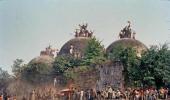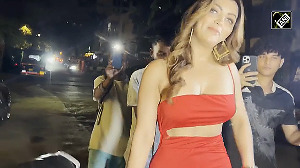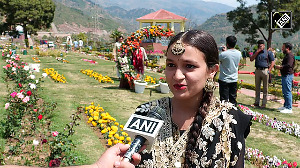Twenty years after the demolition of the Babri Masjid, India is in rebirth mode.
Whether there is a Babri Masjid or a Ram temple or not in Ayodhya, India will go on. And it will see many tomorrows, says Syed Firdaus Ashraf.
Kamar mein lungi mooh mein paan, bhago saale Pakistan
(Your lungi tucked at the waist and paan in your mouth, you buggers run to Pakistan)
Musalmanoon ke do hi sthaan, Pakistan ya kabristan
(Muslims have only two places to live in: Pakistan or the graveyard)
Twenty years ago, I heard these slogans for the first time. I was 21, and in the final year of graduation.
These slogans were being hurled by a mob of Shiv Sainiks led by the local Shiv Sena corporator outside our home. After an hour, a group of Rashtriya Swayamsevak Sangh volunteers in khaki shorts joined the chorus.
Our family was one of the ten Muslim families living in the northwest Mumbai suburb of Malad, surrounded by at least 10,000 Hindu families.
On December 7, 1992, the day after the demolition of the Babri Masjid, riots erupted all over Mumbai. The city cooled down temporarily after a fortnight. But a month later, the riots began once again. This time around, the riots were bloodier, murderous.
Muslim homes and shops were targeted systematically in the second round of riots. My writer-poet father, who is always immersed in his books, could not believe what was happening to Bombay, as it was known then, and did not know what to do about his family's safety.
One night, a Muslim acquaintance came home and told us not to worry. He told us he had a 'ghoda' with him. My innocent father didn't know what the man meant, and asked him what he would do with a horse at this time when riots raged through our area.
My father asked me if I had seen a horse in our building. I nodded no.
The acquaintance then took out a 'gun' and told us this was the 'ghoda he was speaking about.' My father almost fainted; he had never seen a gun in his life.
The acquaintance told us not to worry and said he would "fire one round in the air and the mob of 1,000 Hindus would run for their lives." Even if the mob did not run away, he declared, "We will surely kill five of them and get shahadat (martyrdom)."
My dumbstruck father did not want to listen to the acquaintance's boasts and asked him to leave.
Just then, my grandfather's home in the same area was attacked by rioters. My uncle and aunt fled and we had no idea where they had disappeared.
In those days when there were no mobile phones, rumours were apparently the best things to believe in. Some said one of my uncles was butchered by the mob; others said my uncle and aunt were safe at a friend's home. We had no idea what had happened to them.
In the absence of 24-hour television channels and mobile phones, rumours were so widespread that in our 10,000-strong Hindu area, everyone believed that Muslim mobs would arrive in trucks with AK-56 guns and mow down everyone.
Till date, I don't know how people were brainwashed to such an extent. Every youngster had some kind of sword, stick or brick in hand. People were sleeping on terraces and guarding their buildings as if some Mohammad Bin Qasim (the first Muslim conqueror of Sindh in India) was coming to Malad with his armies from Arabia.
Every night the entire area kept awake, but there was no sign of Mohammad Bin Qasim and his armies.
One of my Hindu neighbours took my family to their home and said, "You should not sleep in your home as you could be attacked."
The next day, there was more depressing news. Every Muslim shop in the area -- be it a grocery shop, milk shop or furniture shops -- had been burnt down by the Hindu mobs. One Muslim man had the misfortune of losing his way in our area. He was thrashed and killed while his mother wept and pleaded with the mob to spare his life.
My neighbours felt it was not safe for us to live in a Hindu area and believed we should move to a Muslim neighbourhood as soon as possible.
I salute my neighbours -- one a Hindu, the other a Christian -- who drove my family amidst the riots to a Muslim area, risking their lives in a Muslim neighbourhood.
Twenty years later, when someone asks me, what do you feel about what happened to you and your family 20 years ago, I tell them I only know that two good human beings saved my family's lives. If they had not been there, you would probably have not read this column.
Of course, I was angry about how people threw me out of my home, only because I was a Muslim. After the riots, living in a Hindu area was impossible for us. When we returned to our Malad home, things were never the same.
After the 1993 riots, Bombay was no longer the same.
We moved out of the area where we had lived for twenty years -- since when I was a child -- and bought a house in a Muslim ghetto. My parents live there to this day.
Four years later, in 1996, I was assigned to do an feature on Kashmiri Pandits living in refugee camps in Delhi. I saw how life was hell for the Kashmiri Pandits in those camps after Kashmiri Muslims drove them out of their homeland.
The Kashmiri Pandits were driven out of Kashmir with slogans like 'Kaafiron ko maar daalo (Kill the infidels)' by Muslim extremists.
Just like me in 1992, the Kashmiri Pandits too were refugees in their own country.
In a way, I felt I was more fortunate than them. At least I could go back to Malad and visit my friends, but the Kashmiri Pandits could never go back home. The terrorists were sure to kill them at that time.
Many Kashmiri Pandits were full of praise for some of their Kashmiri Muslim neighbours. They spoke about how these Muslims had saved their lives and gave them safe passage to Jammu and Delhi.
I realised there are many good people -- Hindus and Muslims -- who saved the lives of neighbours who followed a different faith.
From the 1992-1993 riots, I decided I would always look forward to people like the Hindu and Christian who saved my life and the lives of my family and ignore those who talk about communal issues and communalism.
On another assignment in Akbarpur, then Mayawati's constituency, I discovered how Dalits were harassing Brahmins by lodging fake cases against them under the Dalit Atrocities Act. It was no different to be a Muslim in Mumbai in 1992-1993 and a Brahmin under Mayawati's rule.
In the aftermath of 1992-1993 -- years that will always remain a watershed in India's history -- I often pondered about the Ram Janambhoomi and Babri Masjid issue that had provoked the riots.
I found some answers in V S Naipaul's A Wounded Civilization where he writes: 'Dynasties rose and fell. Palaces and mansions appeared and disappeared. The entire country went down under the fire and sword of the invader, and was washed clean when Sarayu (the river in Ayodhya) overflowed its bounds. But it always had its rebirth and growth.'
Twenty years later, India is in rebirth mode.
L K Advani, who led the Ayodhya movement, claims December 6, 1992, when the Babri Masjid was demolished, was the saddest day of his life. Sadhvi Rithambara and Ashok Singhal, who spearheaded the movement, have become political fossils.
No young Muslim recalls the name of the then self-proclaimed Spokesperson for the Muslims, Syed Shahbuddin, or the late Imam Bukhari of the Jama Masjid who told the Muslims of Mumbai after the riots to hang black flags on January 26, Republic Day.
Naipaul further recounts what novelist R K Narayan told him before his maiden visit to India. 'India will go on,' Narayan had said.
Whether there is a Babri Masjid or a Ram temple or not at Ayodhya, India will go on -- and it will see see many tomorrows.










 © 2025
© 2025